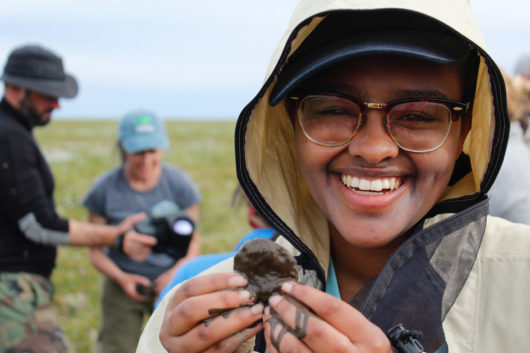 While traveling in the slow-moving morning commute from the suburbs of Massachusetts to Boston, I have time to reflect on my experiences that have led to this point. As a returning student, knowing the unknown is refreshing. Like most people, before participating in the Polaris Project last year, I could only imagine what the tundra looked like, felt like, sounded like, etc. The tundra was completely unknown to me.
While traveling in the slow-moving morning commute from the suburbs of Massachusetts to Boston, I have time to reflect on my experiences that have led to this point. As a returning student, knowing the unknown is refreshing. Like most people, before participating in the Polaris Project last year, I could only imagine what the tundra looked like, felt like, sounded like, etc. The tundra was completely unknown to me.
Now going back, I can relate to the many metaphors used to describe the tundra landscape, including sponge-like, from the thick layers of moss, or ankle-breaker, from the tussocks. For reference, in the summer, there is no snow, and the temperatures fluctuate somewhere between 40-70 degrees F throughout the day. It remains daytime almost 24/7 with about three hours of dusk each night. And, the tundra is a lush ecosystem compared to what you may expect in the Arctic. There are many shrub, moss, forb, and lichen species. The vegetation holds a special place in my heart as they are critical to my research.
The focus of many students’ research is on the changing role fire is playing in the ecosystem. The Yukon-Kuskokwim Delta (YKD), Alaska experienced one of its worst fire seasons in recent history in 2015, making it an interesting place to study its impacts. Plus, the YKD is a wetland tundra, which makes this site even more fascinating as these ecosystems are generally considered less vulnerable to fire.
Overall, studies by WHRC scientists show wildfires in the tundra and YKD are increasing due to climate change. The reasons to study wildfires in this area vary, but all are important. Research suggests that fires may affect the global carbon budget, which is important because the tundra stores more carbon, and other greenhouse gases than currently in the atmosphere, mostly in permafrost. This increase in wildfires may also change the ecosystem on a larger scale, impacting the vegetation and animals that inhabit the tundra as well as having socioeconomic and fire management implications.
My question that I began developing last year and am still pursuing this year is how does this change in wildfire frequency impact vegetation and nutrient cycling? I am answering this question by comparing vegetation samples from 2015 burn scar areas, 1972 burn scar areas, and unburned areas. Much of my time in the field is spent collecting plants and sorting them by species. This year, the focus of my fieldwork will be resurveying areas I traveled to last year as well as surveying as many fire gradients as possible, sites that have a 2015 burn scar, 1972 burn scar, and unburned areas all in close proximity. My research from last year suggests that the ecological impacts of fires remain over many decades, as they are still seen in the 1972 burn scar. For example, I found an increase in plant nutrient content that remains in the 1972 burn scar that may drive an increase in shrubs. Specifically, certain species were larger and thicker in the 1972 burn scar compared to 2015 burn scar and unburned areas. This increase in shrub biomass is interesting; and if true across the ecosystem, it could have serious implications for the future of the tundra ecosystems. Shrubs are more flammable than much of the other vegetation, so with this, and the changing climatic factors increasing the tundra’s vulnerable to fire, this could create a fire-fuel feedback. Areas already burned, over the long term, may be more susceptible to being burned again, increasing fire presence in the ecosystem.
I am almost at Logan now about to embark to on a what I believe to be about a 10-hour trip to Anchorage.
And, while I have traveled to the tundra before, the many impacts of fire and climate change remain unknown, and for that reason, I am excited to get started on my fieldwork again!
— Natalie Baillargeon is a student at Hampshire College and member of The Polaris Project classes of 2018 and 2019



